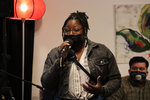
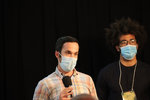

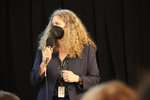
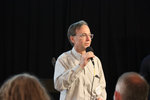
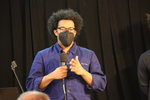
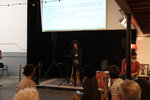

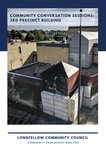
Two years after the protests following the death of George Floyd, the 3rd Precinct building at E. Lake St. and Minnehaha Ave. is still surrounded by barbed wire and concrete bollards. Windows remain boarded after a fire and looting.
Two sessions were held in May 2022 to discuss what the community would like to see happen at the building. One was online on May 9, and the other in person at Squirrel Haus Arts on May 16. The events were sponsored by Longfellow Community Council, Seward Redesign, Lake Street Council, Longfellow Business Association and Longfellow Rising.
In all, 75% of participants don't want the site to be renovated as an MPD station.
In small groups, residents shared their thoughts on whether they want a precinct in the neighborhood and how to address the trauma that remains. Then, they came together to share what was said with the larger group of about 75 people. About 90 attended the online session.
In person at the May 16 event were council members Jason Chavez and Robin Wonsley Worlobah, along with Minneapolis Interim City Coordinator Heather Johnson and a few other city staff. (Ward 12 council member Andrew Johnson was out on paternity leave.)
LCC Community Organizer Bennett Olupo observed that throughout the sessions, folks have mentioned the trauma associated with the Third Precinct building. “People felt abandoned by the police,” he said.
Initially, police hunkered down around the Third Precinct building, aiming at the crowd that had gathered from positions above and on the ground. Later, they abandoned the building. People around the world watched on television and saw photos of the Third Precinct and surrounding buildings in the neighborhood looted and burned, including Minnehaha Lake Wine & Spirits, GM Tobacco, AutoZone, el Nuevo Rodeo building, Gandhi Mahal, MIGIZI, the Minnehaha Post Office, Wendy’s and a multi-story housing complex. Residents woke up to smoke in the air and ash covering their houses.
Some want the Third Precinct building torn down and the lot leveled like those nearby. Others explored repairing it and reusing it, with and without the police presence.
“Half of us are for MPD not returning and half of us in support,” reported Mollie O’Connor. As members of her small group discussed things further, they reached a middle ground, she said, and agreed there is a need for a precinct in the neighborhood “but it doesn’t have to be in the precinct building.”
The Third Precinct covers 58.4 square miles and is the city’s largest. Its boundaries are I-94 to the Mississippi River, down to Highway 62 and over to 35W. About 103,000 people live in the area. Third Precinct officers were initially housed in the Minneapolis Convention Center and are currently based out of the downtown City of Lakes Building near city hall. Some residents are concerned that this means it takes officers too long to respond to calls in the area and the neighborhood isn’t safe because of that. Others pointed out the squad cars do not need to stay downtown but can be on patrol in the Third Precinct during their shifts.
“Until I feel safe, it’s not a safe neighborhood,” remarked one person of color who fears how the Minneapolis Police treat people of color.
There is no requirement that a precinct must be located in the area it serves, according to Minneapolis Interim City Coordinator Heather Johnston. The city has been looking at various sites in the Third Precinct, but has not made a decision about the location.
Throughout the meeting, folks suggested that other entities either fill the entire building or share it with police. These might include mental health providers, county services, violence prevention units, services for survivors of sexual assault, support for the unhoused, and more. Some want the building preserved as a memorial.
“People come from out of town to see George Floyd Square,” remarked Aaron Hosansky. They also come to the Third Precinct site. His son was three and a half when “he moved out of town for the weekend.” Hosansky is considering how he will tell his son about what happened in his city and at the Third Precinct site. “How can we tell our story?” he asked.
Residents pointed out that the lot at Minnehaha and E. Lake St. is a prime one in the neighborhood. It might be better suited to a use that is more community-driven.
There was a suggestion that police share the Metro Transit facility nearby.
TRAUMATIZED
Residents do not feel that their voices have been heard, and there hasn’t been enough community engagement on this issue. They want engagement that is equitable and empowering, not top down but rather bottom up. “Not enough people have been asked what this means to them,” stated one speaker.
“Whatever happens won’t go well unless we find a way to heal the trauma that has happened,” said Doug Mork.
Ward 9 Council Member Jason Chavez (who took office in January 2022) believes that to address the trauma, “We need to listen to the people that live here.” He added, “As a council member, we have fallen short.” Chavez said that as a representative of the people, he will take action from what he hears. “We need to see structural change to the police department,” he said.
The first time Robin Wonsley Worlobah was tear-gassed happened outside the Third Precinct. She was handing out food and supplies. Now as the Ward 2 council member, she is voting to pay out million of dollars to victims of police misconduct. “There is so much work we have to do,” said Wonsley Worlobah. “I ran on it.”
She envisions getting to a place “where that site is known for something else.” She wants the world to be able to point and say, “Minneapolis got this right.” She wants “us to show the world, we are committed to doing better.”
Due to the misconduct, there is a distrust of police. “What do we have to do to regain trust?” asked Wonsley Worlobah. She supports doing restorative work, and proposed a resolution that would direct $100,000 to hire a consultant to engage with community members more about the Third Precinct. It was passed on a 10-1 vote.
Powderhorn resident Duaba Unera pointed out that he and Sam Gould have been engaging with residents in conversation about the holistic development of the East Lake Street corridor since the summer of 2020. They started at Chicago and E. Lake, and moved to the outdoor space north of Moon Palace Books in March of 2021. They established Confluence Studio, An East Lake Studio for Community Design, and are based out of the studio’s autonomous mobile media unit. Learn more at confluence-studio.org.
LCC will be sharing its final report from the meetings. To learn more about next steps, sign up for the newsletter at longfellow.org.
Comments
No comments on this item Please log in to comment by clicking here